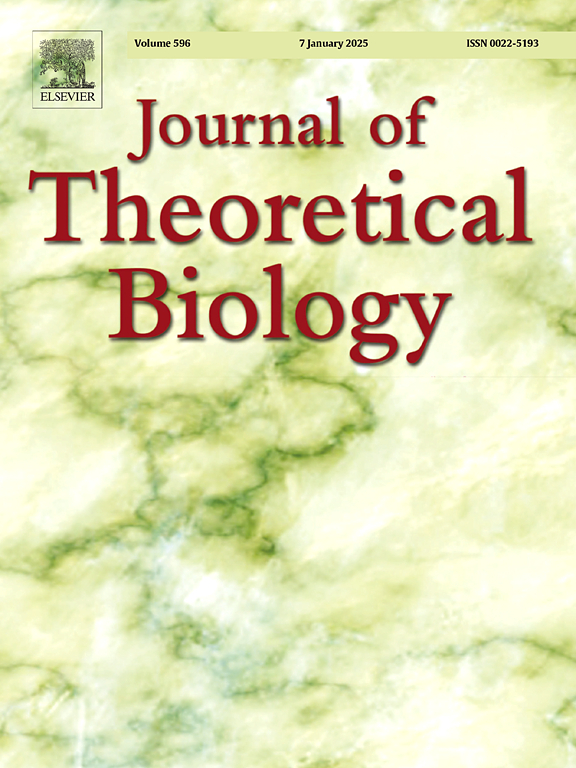简单调控遗传相互作用的适应度景观显示普遍的杂合子优势,支持稳定的多态性。
IF 2
4区 数学
Q2 BIOLOGY
引用次数: 0
摘要
尽管基因表达调控是基因型、表型和适应性之间的基本联系,但人们对自然选择如何推动其进化知之甚少。为了解决这一空白,我们使用了转录因子(tf)的等位基因变体与其顺式调节结合位点之间的分子相互作用的生物物理(热力学)模型。我们建立了二倍体基因型-表型图谱用于基因表达。然后,我们将高斯适应度函数应用于这些地图,其中环境决定了最佳表达水平。相应的基因型适应度景观以杂合子优势高脊为特征。当环境决定的最佳表型位于两个纯合子的表型之间时,杂合子优势就会发生。为了确定这种优势是否会导致稳定的多态性,我们对201个最佳表达水平中的每一个确定了所有等位基因组合的频率-适应度景观(等位基因频率与适应度);使种群平均适应度最大化;识别出具有全局最大平均适应度的组合;找到了它们的平衡等位基因频率。当最佳表型位于两个最佳纯合子的表型之间时,就会出现全局稳定的多态性。稳定多态性占最佳表达水平范围的49% -75%,这取决于生物物理和适应度参数。几乎所有的基因都包含TF多态性,结合位点共多态性在33-55%的范围内。中性多态性也广泛分布。TF-cis相互作用的分子复杂性和多效性约束对多态性都没有定性影响。然而,遗传负荷与分子复杂性呈负相关,表明遗传负荷的降低可能是增加调控遗传相互作用复杂性的重要机制。虽然这一分析假设了环境同质性,但结果表明,这种现象可能增强了环境异质性在维持调控多态性中的作用。选择有利于多态性的维持,不仅因为不同的纯合子在不同的环境中具有更高的适应性,而且因为杂合子优势可以在环境状态之间的过渡中通过促进调控多态性而起到“存储效应”。我们使用该模型来预测未来的进化轨迹,在一个充分记录的案例中,涉及高山兰花花色的调节杂合子优势。需要对种群内调控多态性的程度和维持进行更多的实证研究。本文章由计算机程序翻译,如有差异,请以英文原文为准。
Fitness landscapes of simple regulatory genetic interactions show pervasive heterozygote advantage and support stable polymorphism
Although the regulation of gene expression is a fundamental link between genotype, phenotype, and fitness, little is known about how natural selection drives its evolution. To address this gap, we used a biophysical (thermodynamic) model of molecular interactions between allelic variants of transcription factors (TFs) and their cis-regulatory binding sites. We generated diploid genotype-phenotype maps for gene expression. We then applied a Gaussian fitness function to these maps, where the environment determines optimal expression level. The corresponding genotype-fitness landscapes are characterized by high ridges of heterozygote superiority. Heterozygote advantage occurs whenever the environmentally determined phenotypic optimum lies between the phenotypes of the two homozygotes.
To determine whether this superiority could lead to stable polymorphism, for each of 201 optimal expression levels we determined frequency-fitness landscapes (allele frequency vs. fitness) for all allelic combinations; maximized their population mean fitnesses; identified combinations with globally maximal mean fitness; and found their equilibrium allele frequencies. Globally stable polymorphisms occurred whenever the phenotypic optimum laid between the phenotypes of the best two homozygotes. Stable polymorphisms occupied 49–75% of the range of optimal expression levels, depending on biophysical and fitness parameters. Virtually all included TF polymorphism, with binding site co-polymorphisms across 33–55% of the range. Neutral polymorphisms were also widely distributed. Neither molecular complexity of the TF-cis interaction nor pleiotropic constraint had qualitative effects on polymorphism. However, genetic load was negatively correlated with molecular complexity, suggesting that reducing genetic load may be an important mechanism for increasing the complexity of regulatory genetic interactions.
While this analysis assumes environmental homogeneity, the results suggest that this phenomenon may enhance the role of environmental heterogeneity in maintaining regulatory polymorphism. Selection favors the maintenance of polymorphism not just because different homozygotes have higher fitness in different environments, but also because heterozygote advantage can act as a ‘storage effect’ by promoting regulatory polymorphism during the transitions between environmental states.
We use the model to make predictions about future evolutionary trajectories in a well-documented case of regulatory heterozygote advantage involving flower color in an Alpine orchid. More empirical research on the extent and maintenance of regulatory polymorphism within populations is needed.
求助全文
通过发布文献求助,成功后即可免费获取论文全文。
去求助
来源期刊
CiteScore
4.20
自引率
5.00%
发文量
218
审稿时长
51 days
期刊介绍:
The Journal of Theoretical Biology is the leading forum for theoretical perspectives that give insight into biological processes. It covers a very wide range of topics and is of interest to biologists in many areas of research, including:
• Brain and Neuroscience
• Cancer Growth and Treatment
• Cell Biology
• Developmental Biology
• Ecology
• Evolution
• Immunology,
• Infectious and non-infectious Diseases,
• Mathematical, Computational, Biophysical and Statistical Modeling
• Microbiology, Molecular Biology, and Biochemistry
• Networks and Complex Systems
• Physiology
• Pharmacodynamics
• Animal Behavior and Game Theory
Acceptable papers are those that bear significant importance on the biology per se being presented, and not on the mathematical analysis. Papers that include some data or experimental material bearing on theory will be considered, including those that contain comparative study, statistical data analysis, mathematical proof, computer simulations, experiments, field observations, or even philosophical arguments, which are all methods to support or reject theoretical ideas. However, there should be a concerted effort to make papers intelligible to biologists in the chosen field.

 求助内容:
求助内容: 应助结果提醒方式:
应助结果提醒方式:


